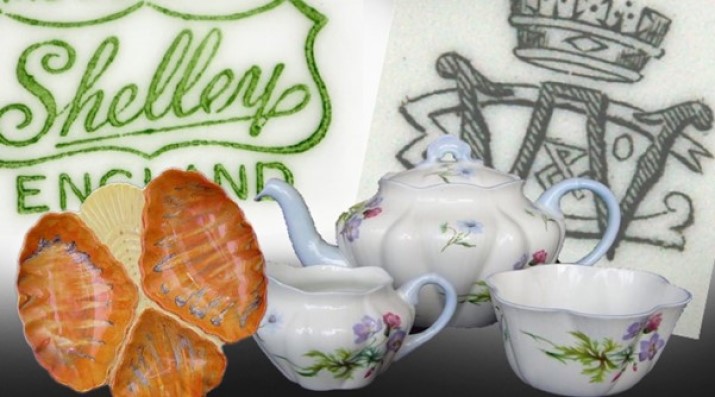
Shelley pottery is best known for its tea ware and is still popular around the world today.
Based in Staffordshire, Shelley pottery has been producing stunning bone china pieces under various names since the 1870s. The pottery is thin but strong, and the beautiful, timeless designs have created fans and serious collectors worldwide.
But how much is your Shelley pottery worth? And how do you identify the backstamps and markings to determine if you piece is an original?
Our Shelley pottery markings guide will help you uncover valuable and rare Shelley pieces. Keep reading to learn more about Shelley pottery and Potteries Auctions expert services.
The History of Shelley Pottery
Famous for the manufacturing of fine china and earthenware, the Shelley factory sadly no longer exists, but its name and production legacy lives on. Shelley pottery really took off and increased in popularity after the war years, becoming especially known for its fashionable tea ware.
The history of Shelley pottery dates back to the 1870s, when it was originally named Wileman & Co, followed by The Foley Potteries, before the final use of popular name ‘Shelley’ was confirmed in the 1900s and Percy Shelley adopted the Shelley name as a trademark.
The history of the Shelley name continued to be complicated. Confusion and competition broke out with the name ‘Foley’ when another company used this name on their pottery. This is reflected on the backstamps of early pieces, and you may find stamps stating, ‘Late Foley’.
In 1965, Shelley became part of Allied English Potteries (A.E.P) and the production of Shelley ware was stopped. Sadly, all the factories were destroyed, and the only remaining legacy is the outstanding quality of the Shelley range.
If you are looking to expand your Shelley pottery range, or if you’re missing a key piece from your set, our experts can help you curate the perfect collection of valuable Shelley pieces. Or if you want to sell your collectable Shelley items, our professional team can help, providing experienced valuations and auctioneers. You can read our guide to buying and selling at auction here.

This exquisite collection of Shelley Chintz cups and saucers in various designs, including Marguerite, Countryside, Rock Garden, Melody sold for an unbelievable £800 at one of our antique, rare pottery and fine art sales.
Why is Shelley Pottery Popular?
Shelley Art Deco tea wares are often the most popular and valuable of the Shelley range. The shapes and styles proved extremely popular in America as the shapes really did break the rules, but they looked incredible and really added to the reputation of Shelley. However, it was Mabel Lucie Attwell’s children’s ware and figures that became extremely popular and are still highly sought after today.
 Whilst Shelley pottery is most commonly known for its teaware and fine china, it also produced numerous figurines such as this Shelley Mabel Lucie Attwell Boo-Boo Pixie figure riding on a dog. This interesting piece sold for £100 in a rare pottery sale back in 2018.
Whilst Shelley pottery is most commonly known for its teaware and fine china, it also produced numerous figurines such as this Shelley Mabel Lucie Attwell Boo-Boo Pixie figure riding on a dog. This interesting piece sold for £100 in a rare pottery sale back in 2018.
What Shelley Markings Should I Look Out For?
Over the years, Shelley pottery has created thousands of designs and used hundreds of different patterns. Often these were recorded with numbers and names. For example, each cup design was given a specific name such as ‘Dainty’, ‘Bute’ and ‘Ovide’. Due to this naming, you’ll find various markings and backstamps on all Shelley pottery and china. The long history of production and various name changes of the company also mean multiple back stamps have been used.
Shelley Trademark Backstamps
Below is a list of the most used stamps over the years. There are lots of variations on the markings below and you’ll often see the design name next to the stamp.

From the Wileman ownership, you’ll find variations of the following stamp. It may include “Made in England”.


The Foley name was introduced up until 1910.

From 1910-1916, the words “Late Foley” were added to some pieces to represent the history of the pottery. This was also when the recognisable Shelley shield was first used.

You might find pieces with the Shelley shield used on its own. This was used up until 1925.

This stamp was used from 1925-1945.

From 1945-1966, this following variation was used.

The Shelley miniatures had a slight variation of stamp, which was used until the 1950s.
Photo Credit: Back Stamp Markings
How Much is My Shelley Pottery Worth?
At Potteries Auctions, we can identify and provide valuations on a wide range of Shelley pieces. Our team can help value your collection, turn you into a collector on advise on how much your Shelley Pottery could be worth.
Please get in touch with us to discuss how we can help you or request a call back if you are looking for an expert evaluation and are seeking to sell your Shelley pottery.
Did you know we conduct valuations around the world? With Zoom appointments and email valuations we offer a worldwide service. Shelley pottery is currently very popular with the Asian market and Potteries Auctions is perfectly placed to deal with global clients. Please get in touch with us for more information.
